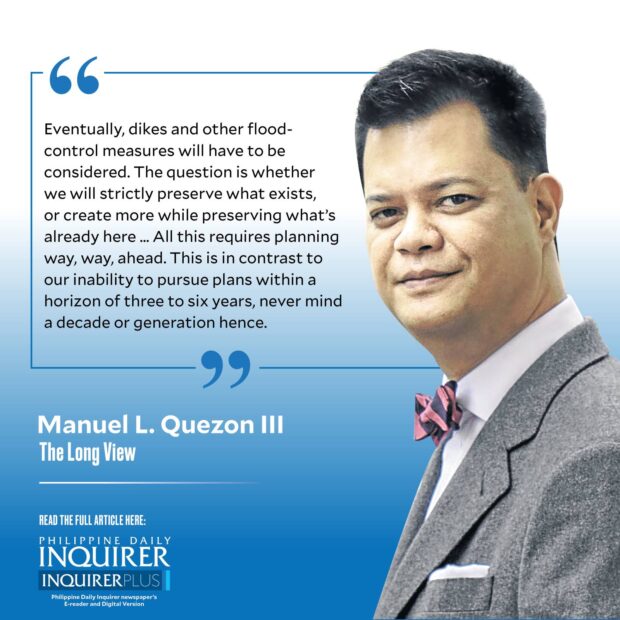
A Forbes report stated that 25 percent of Hong Kong’s developed land is reclaimed, where 27 percent of its population is housed and where 70 percent of business activity takes place. The same report states that Singapore is the world’s largest importer of sand—and the New York Times actually took a look at the sand reserve of the city-state (Malaysia, Indonesia, and Vietnam have banned sand exports to Singapore, leaving it with Cambodia as its current source), even as they have embarked on adopting a new type of reclamation which uses less sand. It’s known as polders and, explained Forbes, “involves building a wall to keep seawater out while using drains and pumps to control water levels.”
Still, the most common reaction I got was, “Oh yes, Changi and Marina Sands are all reclaimed.” Since we Filipinos suffer from a terminal case of Singapore-envy, perhaps it’s useful to take a closer look at reclamation and Singapore.
It’s interesting to bear in mind that Singapore, which expanded its territory by 22 percent in the first 50 years of its independence and plans to expand its land area by 8 percent or 100 square kilometers by 2030 is continually restudying what to do with its land. Its Urban Redevelopment Authority gives the example of “Adaptive Lifecycle Planning,” where the ports will be relocated to make way for what’s called “the Great Southern Waterfront.”
The first part of the scheme involves the construction of a continuous waterfront promenade (imagine, now that long stretches of Roxas Boulevard as a seaside promenade are obsolete, the creation of a new, pedestrian-friendly one along the shore of the existing, and future, reclaimed areas in Manila and Pasay can restore the sunset view and sea breeze access to the public which only really gets to experience it at the Cultural Center complex and Mall of Asia). The promenade, too, will serve to connect existing parks and nature reserves (again, these could be created in our current and future reclaimed areas).
Singapore’s reclamation means its population’s needs can be met while allocating land for parks and recreation to maintain its ratio of 0.8 hectares of park space per 1,000 civilians. Contrast this with our own track record of justifying the reduction—the elimination—of parkland to accommodate developments.
The blunt reality is that reclamation is a survival strategy for Singapore. An environmental report acknowledges that “In reality, Singapore is in a perpetual state of crisis; as increased rainfall from global warming continues to raise the sea level each year, the small country comprised of numerous shrinking islands often lacks sufficient land to support its growing population and economy. While some engineers proposed constructing infrastructure in the sky and on floating platforms in the Indian Ocean, Singapore’s government instead employs another capital-intensive land formation strategy: land reclamation.”
We face a similar challenge from rising water levels. Eventually, dikes and other flood-control measures will have to be considered. The question is whether we will strictly preserve what exists, or create more while preserving what’s already here. This is a strategy being adopted by New York, Miami, Rio de Janeiro, and Mumbai, all of which are in various stages of considering reclamation ”to protect themselves against rising tides and prevent themselves from vanishing altogether.”
Meanwhile, here at home, there is the perpetual call to depopulate Metro Manila when other cities are planning for the continuing, and not decreasing, influx of future residents. From 30 percent living in urban areas back in 1950, today, about 55 percent of the global population already lives in urban areas, with the percentage expected to reach 68 percent by 2050. Singapore, for its part, foresees that by 2100, “Singapore’s temperature is projected to rise by 1.4 degrees Celsius to 4.6 degrees Celsius and sea levels could rise by up to 1 meter. The intensity and frequency of heavy rainfall events are also likely to increase while conversely, dry seasons could become even drier.”
For them, it means flood walls, catchments, flood gates, and pumping stations—for others, like the Koreans, it means reclaiming land for farming. What these places are doing is to proactively plan for the future, instead of wishing problems away or steadfastly preserving the status quo—which is not particularly inspiring, relevant, or healthful as it is—to the exclusion of creating new opportunities.
All this requires planning way, way, ahead. This is in contrast to our inability to pursue plans within a horizon of three to six years, never mind a decade or generation hence.
Email: mlquezon3@gmail.com; Twitter: @mlq3